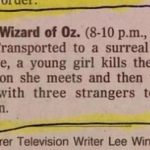The Logline
The logline of your screenplay is a simple sentence or two that acts as a short synopsis of your story and provides the emotional hook that will make any agent or producer wish to read your script. You include the logline of your screenplay within your initial query letter whenever you are soliciting interest in your script from an agent or producer.
A well written logline should be carefully thought out. You have two sentences at most to convince people that your script is worth the time and effort to read, which will hopefully lead to a sale. A logline is also a useful time-saving device. If you are talking about your screenplay to anyone (from friend to Hollywood star) and they ask you what it’s about then you can simply quote your logline. There should be something about that logline which really stands out and makes whoever hears it want to read the full story.
Your logline also allows you to “big up” your story so it sounds as high concept as possible. Producers love high concept scripts as they are easy to market. That means even if your story isn’t particularly high concept you can use you logline to embellish on it’s most intriguing points.
Anatomy of a Logline
The anatomy of a logline is relatively straightforward. In every story there is a main character who has a problem and has to achieve a certain goal in order to solve that problem. You need to explain WHO has the problem, WHAT the problem is and HOW they are going to overcome it. All this is to be explained in one or two sentences. The snappier it is the better.
 Examples of Good Loglines
Examples of Good Loglines
One of the best ways to get good at anything is to see how the masters do it.
“One man’s struggle to take it easy.” – Ferris Bueller’s Day Off
“Unchanged men in a changing land. Out of step, out of place and desperately out of time.” – The Wild Bunch
“To enter the mind of a killer she must challenge the mind of a madman.” – The Silence of the Lambs
“After he’s wrongly convicted of murdering his wife, a high-powered surgeon escapes custody and hunts down the real killer, a one-armed man.” – The Fugitive
“On every street in every city, there’s a nobody who dreams of being a somebody.” – Taxi Driver
You should now notice how the logline tells the reader the very spine of the story while accentuating the most interesting points. Lets dissect the logline from The Silence of the Lambs and see how it answers the WHO, WHAT and HOW.
WHO: A woman must (“…she…”)
WHAT: get inside the head of a killer (“To enter the mind of a killer…”)
HOW: by challenging his warped mind (“…challenge the mind of a madman.”)
The logline paints the picture of a disturbing psychological thriller with the added twist of a woman (seen as vulnerable, especially compared to a killer) in the role of investigator. The Silence of the Lambs is a complex story so if that story can be surmised in a sentence there is no reason yours can’t!
Loglines as the Starting Line
Many beginning scriptwriters don’t even consider a logline for their screenplay until after at least the first draft is written. In my opinion this is a mistake. Writing a logline should be one of the very first things you do. It helps YOU understand the core of your story right from the get go, preventing getting half way through a script and being unsure what direction to take it in. Write down the WHO, WHAT, HOW and piece together a logline and paste it up on the wall where you write. Even if you change the logline after you’ve finished the script it will help you remain on track.
Like anything, writing loglines takes practice. One good little exercise is to look at the movies in your DVD collection and come up with loglines of your own.
Well, what are you waiting for?
Please CLICK HERE To Check Out My Top 5 Online Scriptwriting Courses


